
***UPDATE: Fitbit has since released the Fitbit Charge 4, check out the in-depth review here!***
No matter how you slice it, the Fitbit Charge series is Fitbit’s leading line to date. Having sold over 35 million units amongst the various versions, it accounts for the bulk of their sales. Thus despite all attention on the top-end Ionic and Versa units over the past year, there hasn’t been an update of the Charge lineup since 2016 – an eternity in consumer and wearable tech gear. The Charge 2 might as well be a Fred Flintstone watch at this point.
Last week that changed though, with the Fitbit Charge 3. And while it’s still an activity tracker at its core, you’re seeing the gradual transition of not just Fitbit but other companies as well, into eventually making FDA approved medical devices. While this is not a review (that’ll come later), I’ve had a bit of time to get hands-on with the unit and can dive into all the new bits. There’s a surprising number of new features and functions here, including some not yet seen on other units (even their higher-end units). And of course, we’re also seeing some features appended to now lower-cost units that were previously reserved for higher-priced editions.
For those unfamiliar with the Fitbit Charge series, it has always sat in the meaty middle of Fitbit’s product offerings. Usually priced between $125 and $150 ($149 in the case of the Charge 3), it tends to be a step above a basic activity tracker – including things like workout tracking, while not quite having the advanced features of a full ‘watch’, such as the higher end Versa ($199) or Ionic smartwatches ($249).
What’s new:
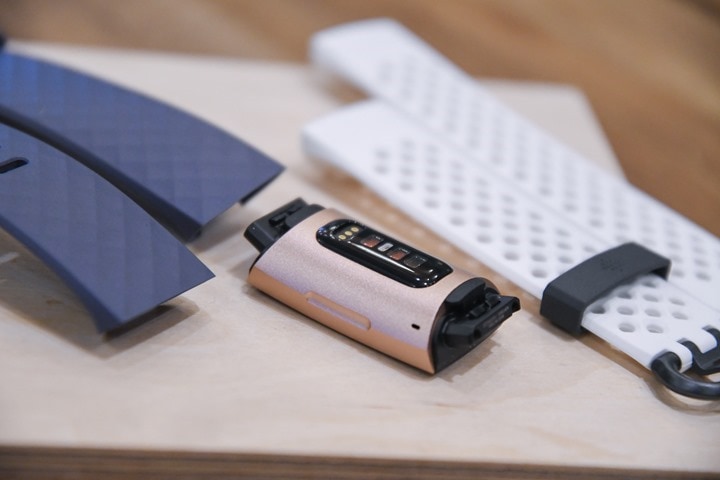
Because life is short, we’re going to get right into the details on what’s new in the Charge 3. Here’s my bulletized list of all the newness (in comparison to the Fitbit Charge 2):
– Finally made it swim/waterproof (up to 50-meters deep)
– Increased battery life from 5 days to 7 days
– Increased usable display area by 40% using new OLED touchscreen
– Increased brightness compared to previous Charge 2
– Added SpO2 sensor (Ionic/Versa have the same sensor too, but previously unused)
– Added female health tracking
– Added NFC/contactless payments (Special Edition in US/Europe for $169, all units in Asia-Pacific)
– Added in ‘sleep disturbance’ tracking (for conditions like sleep apnea, allergies, and asthma)
– Added goal-based exercise targets
– Added automatic run detection
– Added pool swim tracking mode (note: you won’t see distance until post-swim, only time during swim)
– Changed/upgraded device pod to ‘premium aerospace grade’ aluminum
– Changed/upgraded display material to Gorilla Glass 3
– Did I mention that they finally made it waterproof?
– Reduced weight by 20%
– Changed band swappability to just single button press
– Increased processor speed (and thus added small animations…because everyone likes animated GIF’s)
– Added quick text message replies for Android users (Apple blocks this for 3rd party devices on iOS)
– ‘Select’ 3rd party apps coming to device later this year (sorta, it’s complicated)
– Claimed improved heart rate accuracy compared to previous Charge 2 sensor
Also, coming via updates on the mobile app are:
– New ‘dynamic insights’ portion on app, starts to cohesively look at all the data being gathered as related (i.e., sleep versus resting heart rate vs workouts)
– Displaying relative SpO2 via app (for Charge 3, Ionic, and Versa)
– Sleep Score beta dashboard from Fitbit Labs planned later this year
– Additional female ovulation tracking coming soon (currently has menstrual cycle tracking)
As I teased at above, perhaps the biggest item on the list for most people is quite frankly the silliest and the stupidest. It’s now waterproof. I know I’ve given Fitbit a hard time about this over the years – because quite frankly they’ve more than deserved it. As I always note, $10 watches at Walmart have been waterproof for decades, but somehow much of Fitbit’s line hasn’t been. This finally is. The company says you can go swimming with it – and even touts its indoor swimming capabilities. They actually show a legit swimmer in the water with it on their site:

Keep in mind that the swimming functionality in terms of sport modes is still somewhat limited however. For swims, it’ll track your distance, time, and laps. It even allows you to choose the pool size (which enables the accelerometers to determine distance). However, while actually in the pool it’s only going to show your current activity time, not the distance. Distance swam and laps will only be shown afterwards on the mobile app.
This is different from the Versa and Ionic which can show your swim details in real-time. Obviously this is product differentiation, but I wouldn’t necessarily call it out of place. Kinda like the older Withings watches that did the same, only showing swim totals post-swim.
In-line with the new swimming capabilities, they’ve also expanded various other sport features. Specifically around exercise goals. The unit now allows you to specify an exercise goal for one of 15 exercise modes. These goals can be configured around distance, time, and calories. Of course, for activities like Yoga, you won’t get distance as an option (personally, I’d say ‘buckets of sweat’ should also be an option).
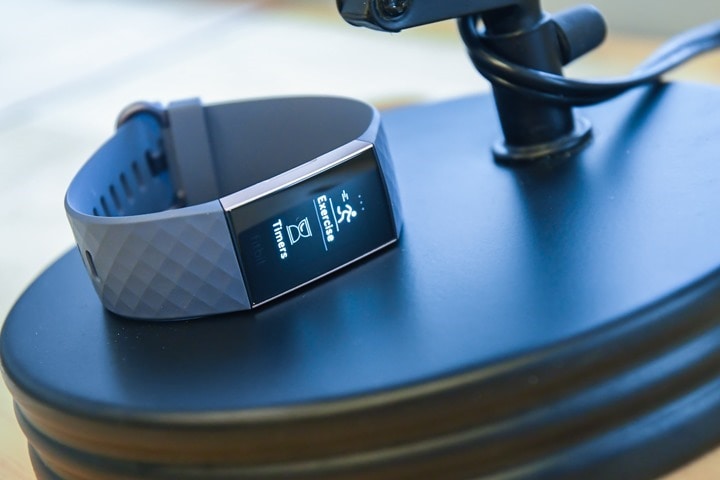
They’ve also added in automatic run detection. This is similar to what they introduced on some of their other devices, including the Ionic and Versa over the past year. It’s also fairly common among wearables, so I’d classify this more as keepin’ up with the Joneses.
On the running and outdoors front, the Fitbit Charge 3 doesn’t have GPS within it. Instead, it uses ‘Connected GPS’, which is a fancy term for ‘your phone’. It leverages the GPS of your smartphone (Android/iOS/Windows) and then records the GPS track that way via Bluetooth Smart. Fitbit has long done this for many of their products. The only current Fitbit product that has GPS within it is the Fitbit Ionic (previously, the much older Fitbit Surge had it too).
In some ways this is Fitbit protecting their higher-end products, though, I’m not entirely sure how much longer they’ll be able to do this. To some degree they can get away with it because they’re Fitbit. Fitbit states the main reason they did so was to protect battery life (which increased from 5 days to 7 days). Certainly that’s true but only to a limited extent, competitors in the same price range already have GPS built-in – such as the Garmin Vivosport. But again, Fitbit.
If you run without your phone, it’ll use the accelerometer internally to measure pace and distance. So you’ll still get those metrics, including calories.
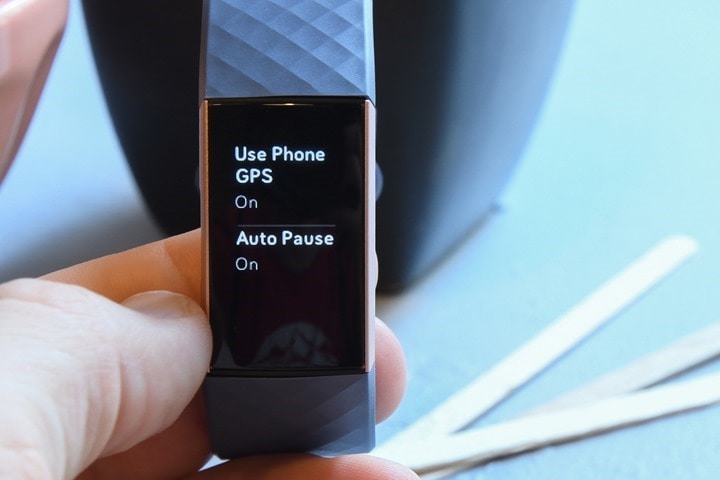
Finally, the company has made a bunch of physical changes as I outlined in the bulleted section above. Most notable is really the size of the touchscreen display being so much bigger. While it may look similar to previous units, the previous ‘screen area’ only had a fraction of that space as usable display. The rest was just border material. Now as you can see, it’s quite a bit bigger display. Also of note is that it uses Gorilla Glass 3, though honestly I can’t remember ever hearing of anyone breaking the display on one previously (though, it should help with scratches).
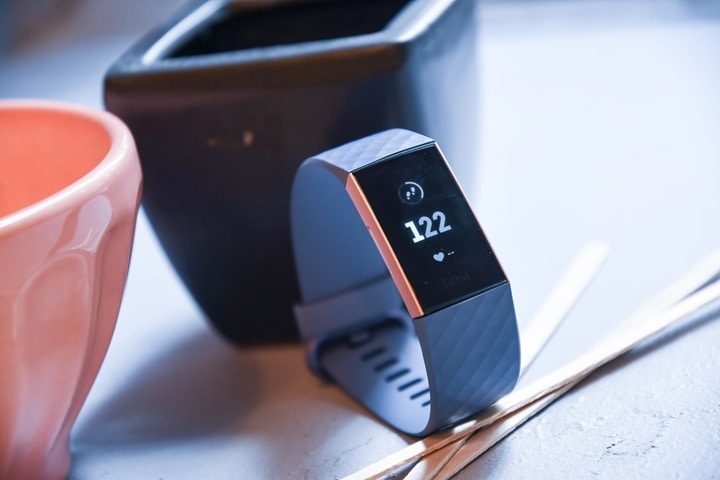
Alongside that, they’ve gone to an “aerospace grade” aluminum for the pod (keep in mind, almost everyone says that), alongside quick detachable bands. These bands detach much much much easier than previous ones, in about 1-second. It’s just a better locking design, so I’ll give them credit for that. As part of all of this they reduced the weight by 20%. And of course, there’s a bunch of new accessory bands.

Oh, and in case you missed it up above – they added contactless payments like the Ionic and Versa. But like those units it also depends on which edition you buy. In the case of the US and Europe markets for example, the base $149 unit doesn’t include NFC payments, but the $169 special edition does (and it includes an extra band). While the Asia-Pacific base variants do include the contactless payments built-in, a likely nod to just how popular contactless payments are in those regions.
With the exception of SpO2 and sleep disturbances tracking that I’ll discuss in the next section, most of the rest of the Charge 3 is just the standard Fitbit related things you’ve known for the last decade or so.
Medical Device Futures:
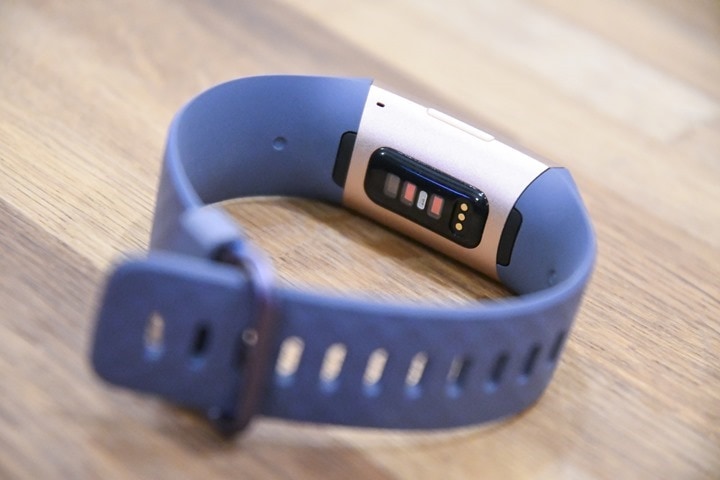
It’s funny how things have changed. Just a few short years ago fitness tech companies were vehemently noting how their devices were not medical devices. In Fitbit’s case, they got themselves caught up when users expected medical-level heart rate measurement quality from a consumer-level product. As such, companies like Fitbit, Apple, and Garmin (among all others) emphatically noted in every manner possible how these devices were not medical devices. The conversation then turned to whether or not they were misrepresenting heart rate accuracy in general (medical issues aside), but that’s another topic for another day.
In the past year though we’ve seen this same set of companies start to make hints at their medical device aspirations. Be it Apple touting medical integrations in their annual keynotes, Fitbit talking at length about the same to press, or Garmin introducing SpO2 readings in their Fenix 5X. Everyone wants a piece of the pie…but they are careful to not ask for the entire pie.
What do I mean?
Well, all of these are made possible by an FDA (Food and Drug Administration) program that allows what are called ‘software as a medical device’ (SaMD). In effect it allows companies like Fitbit to certify only a portion of their device as being medically approved for a given purpose. And more specifically, it allows it to certify a software application running atop a given piece of hardware. That application may not even be Fitbit or Garmin’s, but a 3rd party. This reduces the complexity in certifying an entire device that has boatloads of functions, down to a very specific and thin piece of the pie.
There are a pile of companies in this program, including Fitbit, Apple, Garmin, Samsung, Johnson & Johnson and many more. Last I heard there were more than a dozen companies accepted into the pilot program, out of over 100 applicants.
Take Garmin for example, their announced aspirations are to potentially medically certify their new Pulse Ox technology found in the Fenix 5X Plus. Their goal would be to certify just the specific software application on the watch that touches Pulse Ox. Whether they do that or a 3rd party does that is somewhat up for debate.
Fitbit meanwhile, hasn’t specified precisely what their ambitions are, but it’s clear they’re spending their time on sleep disturbances and now also SpO2. The company has talked about both quite a bit over the last year, but especially sleep disturbances. That’s a catch-all for a number of sleep-related conditions, but especially sleep apnea, atrial fibrillation, allergies, and asthma.
Starting later this year they’ll be rolling out a ‘Sleep Score’ beta dashboard. This will come from their Fitbit Labs group which is heavily focused on R&D, especially with the medical side of things. This dashboard will track sleep quality, and utilizing the SpO2 sensor found in the Charge 3/Versa/Ionic, will start to also start to track SpO2 (note: SpO2 will not be shown in the device itself).
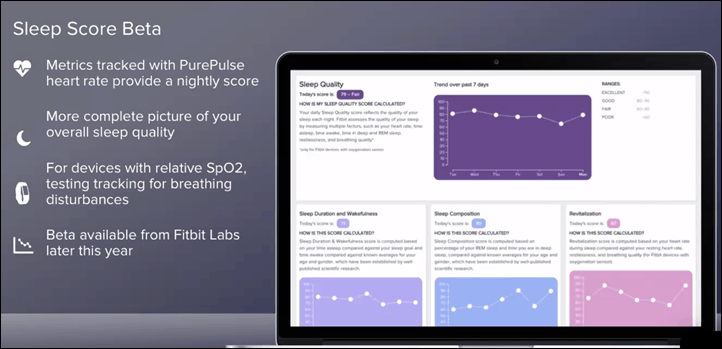
The company says at this point that consumers can utilize that information to spot trends, which they could take to a medical professional to figure out the appropriate next steps. That wording keeps them out of the doghouse for now, until they can get to the point of having proper FDA medical device certification.
But Fitbit was clear about their future here, saying the entire goal of the Sleep Score beta dashboard is that they’re “looking to collect data to get to a FDA device and system” down the road. It remains to be seen how long that road is. I certainly don’t expect it to happen this year, and probably anytime early next year. But for folks suffering from sleep disturbances, this may help bridge the gap a bit in data collection in the meantime.
Wrap-Up:
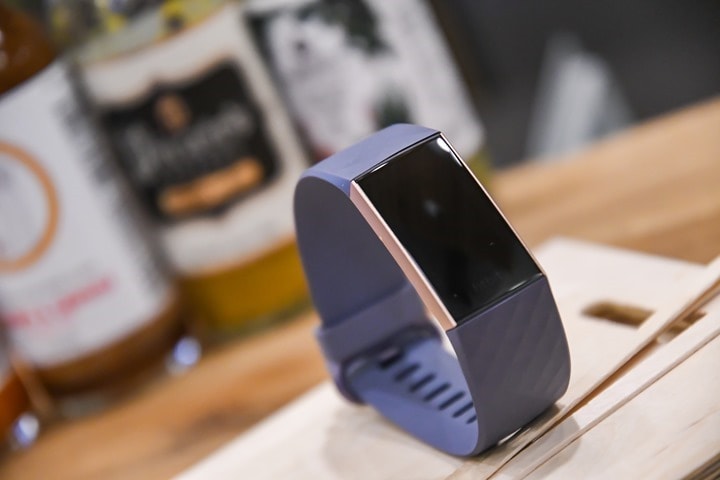
In many ways one can somewhat forgot how much progress has been made over the years with Fitbit’s lower and mid-range activity trackers. Sometimes it can feel like each new release is ‘just another Fitbit’, and in some ways, undercurrents of that are true with the Charge 3.
But I do think there’s actually more than meets the eye here. It seems to be a far bigger jump from Charge 2 to Charge 3 than Fitbit usually has in terms of new features between product editions. Perhaps because it’s been a two-year gap since the last Fitbit Charge model, or perhaps because Fitbit with the Ionic and Versa is finally starting to feel more like a smart device with integrations into 3rd party ecosystems, rather than just a well-designed step counter.
Or perhaps it’s because we’re finally seeing the light at the end of the tunnel in relation to potential medical device status, at least insofar as the sleep disturbance pieces go. Lest we also forget relative SpO2, which is a huge potential differentiator at this price point in the market (depending on how it’s implemented).
I think all are areas that Fitbit seems to be finding ways to say ‘it’s more than just a way to count steps’. Given consumers (in the form of market share over the last two years) have clearly told Fitbit they aren’t unique anymore, the Charge 3 might actually go a ways towards at least pausing that slide, if not perhaps reversing it a bit.
Of course, the proof is in the pudding. And that’s gonna spending some time with a final production unit to see how it handles and what the software platform behind some of these new features looks like. So swing back in about a month or so and I’ll let ya know if this is indeed something that’s going to differentiate them in the market.
With that – thanks for reading!
Found This Post Useful? Support The Site!
Hopefully you found this review/post useful. At the end of the day, I’m an athlete just like you looking for the most detail possible on a new purchase – so my review is written from the standpoint of how I used the device. The reviews generally take a lot of hours to put together, so it’s a fair bit of work (and labor of love). As you probably noticed by looking below, I also take time to answer all the questions posted in the comments – and there’s quite a bit of detail in there as well.
If you're shopping for the Fitbit Charge 3 or any other accessory items, please consider using the affiliate links below! As an Amazon Associate I earn from qualifying purchases. It doesn’t cost you anything extra, but your purchases help support this website a lot.
Since the Fitbit Charge 3 is no longer sold, I recommend looking at
Fitbit Charge 5:
And of course – you can always sign-up to be a DCR Supporter! That gets you an ad-free DCR, access to the DCR Quarantine Corner video series packed with behind the scenes tidbits...and it also makes you awesome. And being awesome is what it’s all about!
Thanks for reading! And as always, feel free to post comments or questions in the comments section below, I’ll be happy to try and answer them as quickly as possible. And lastly, if you felt this review was useful – I always appreciate feedback in the comments below. Thanks!





















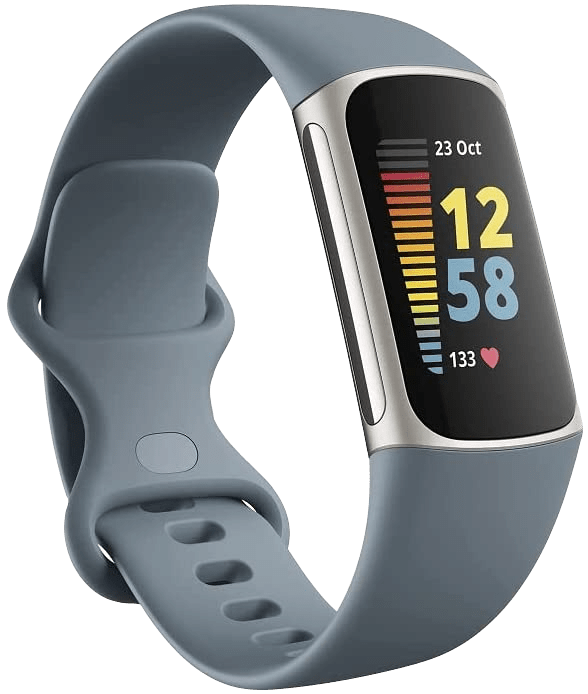













I feel like the aerospace industry really needs to up their alloy game and stop using consumer-grade aluminum.
I’m too deep into the garmin ecosystem to buy it, but I’m happy about the O2 sensor- mostly because it will force garmin to implement the same down the line lest a sub ~$200 Fitbit have a feature missing from a ~$700 fenix
But what does the SpO2 sensor measure/do?!?
I didn’t know either, but Google is your friend :-)
“Blood Oxygen Saturation (SpO2) is a measurement of how much oxygen the red blood cells in the body’s arteries are carrying. Each hemoglobin molecule can carry four oxygen atoms and SpO2 is the percentage of hemoglobin molecules carrying a full load of oxygen. Shown as a percentage, normal SpO2 readings are between 95-100%, with anything lower than 90% providing cause for concern.”
Yeah as far as I know it has no value — it’s either normal or something’s wrong with you, which is a medical issue not a fitness thing.
I think perhaps these sensors might be able to tell you if you’re experiencing sleep apnea, but if you don’t already know about it, it’s not a problem.
The main driver for the readings here is using the data to figure out sleep disturbances.
I’ve got a call tomorrow evening with Fitbit’s sleep team to dive into it a bunch more.
I’m a sleep researcher as my day job – these recent developments to include SpO2 from Garmin, and even more so from Fitbit given the more affordable price point, are really fascinating. The potential implications for how sleep medicine is practised are very interesting.
Medical grade sleep analysis uses polysomnography, which is expensive, cumbersome and often relatively inaccessible. While these consumer devices will clearly not give the same information, if they can usefully integrate movement, heart rate and SpO2 data (*and validate it against PSG*) there’s a lot of potentially clinically useful information there. If they can get to respiration rate as well, even better.
As far as I know the sensor is technically build in but completely useless at the moment, as there is no software using it and also no API action to leverage the data for third party apps. There have been several threads on the fitbit forum discussing that topic with the Ionic watch.
Is this different for the Charge 3? Can you perhaps at least view the O2 data somewhere in the app or the web dashboard? Perhaps fitbit started to move there. Looking forward to the result of your call.
Hi Ray,
quick question: will it be possible to just read the current SpO2 value at any desired time (maybe via an app) or record it during an activity (other than sleeping)?.
I am particularly interested in this as it is a relevant parameter when doing activities in high altitude.
Thank you
Oh, Jan here above just asked basically my same question. And a quick search on Google shows that several people already did in various forums and websites…
There is the obvious use for SpO2: identifying altitude sickness early so any effects can be mitigated before they become detrimental.
But I just thought of another: It’s a carbon monoxide detector. Here’s why:
The hemoglobin in blood transports CO2 to the lungs that’s been respirated by the cells and exchanges it with fresh oxygen, much like people passengers getting on and off of a bus. However, CO (carbon monoxide) binds to hemoglobin (how is unimportant but there are entire university semesters on the concepts) and doesn’t want to let go. This is like a passenger who gets on the bus and falls asleep in the back. He doesn’t get off, and he’s taking up the whole row so new people can’t get on. CO does the same thing: it reduces the amount of oxygen a red blood cell can take on. This would show a abnormally lower oxygen saturation level on an SpO2 monitor and provide notification when there might not be an alarm (say in a hotel). So if you’re in your house or car, and you see your SpO2 go from 97% to 92-93% with you not doing anything – try going outside or opening a window. If it goes back up, then you might have a problem.
I’m not sure this will work. In essence it is reading the coloration of the veinous blood which shows a direct correlation (actually using a lookup table) to oxygen bound to hemoglobin (vs not). If instead carbon monoxide is bound to the hemoglobin the correlation is no longer accurate. Pulse oxymiters give a limitation in their use in the case of CO poisoning. I suspect that a LED device could be created that could detect CO poisoning but not a standard SpO2 monitor. It is an interesting case, however, since it is something that would always be on. Most SpO2 devices currently are used in situations (high altitude, during medical procedures or emergencies) where tailoring to this purpose would not make sense, but in a device always on your wrist? Maybe you should figure it out and run down to the patent office!
RE: How exactly Fitbit will display the SpO2 data
That remains to be seen. :-/
all correction, arterial blood is oxygenated blood, venous blood is blood that has already exchanged its oxygen for the CO2 waste product. Otherwise, your post is right on.
And it looks like our patent-pending idea is 30 years behind the time. Pulse Oximiters effectively overcalculate the level of O2 by the amount of CO present – which makes it useless as a CO detector. (And actually, very dangerous!) But I thank you for making me do a bit of googling. Here’s the link if you’re interested from pubmed.
link to ncbi.nlm.nih.gov
Did you get any info 6 weeks ago? You were going to post a further review a fortnight ago. Did I miss it?
Unfortunately it doesn’t work that way. CO causes SpO2-monitors to show an incorrect (high) measurement, as it’s not a device to distinguish O2 from CO: both bind with haemoglobin and lead to the same ‘reaction’ to the red and infrared light from an SpO2-monitor (without going into detail).
Also used when flying personal plane – oxygen trend/need. I need a watch for training but also SPO2. Do you like the Fitbit, Garmin or something else right now? When will Apple support?
If this really is of vital importance, I’d go for the Masimo MightySat.
I would expect that the cost of getting FDA certification would be passed on to the customer. Complying with government regulations can be an expensive thing to do, especially one as extensive as the FDA ones.
The actual cost of FDA certification can vary quite a bit. In talking with Garmin for example, they were saying the specific certification test for their SpO2 sensor setup would be about $50K.
A quick look at a few online tidbits about device certification costs seems to indicate that’s probably in-line (or slightly high).
Note that certifying a device within a well documented standard (like SpO2 which has very specific test criteria) is relatively easy. It’s getting FDA approval for drugs that’s an entirely different beast.
Obviously, $50K for either Fitbit or Garmin is trivial, especially when Fitbit is talking sales of 15-20 million units per model (so $2.3b in sales of just the Charge 2 over the lifetime with its 15m units sold to date).
Hi Ray, please don’t mix things up like “what are the total sales of Fitbit Charge 2” and “What revenue represents Fitbit Charge 2 for Fitbit”.
You have to consider the retailer margin, and when a product is sold by a third party (retailer) $150 street price, the revenue for the Brand is usually 50% of that.
True, that’s why I didn’t say the word ‘revenue’. ;)
But you are right in spirit, which is that there’s definitely a difference. Fwiw, margin for Fitbit products is about 30-33%.
The point I was making is we’re talking billions of dollars for just one product (that even ignores Versa and Ionic). So paying $50K for SpO2 certification is so far below trivial it doesn’t even matter. :)
Ray – I think you are ignoring somewhat the follow-on costs of having something certified as a medical device. My day job is post-market regulatory affairs for a large medical device company. There’s a pretty huge set of regs that you need to be set up to comply with, entirely apart from filing a 510k to get your device certified.
I’m guessing Fitbit’s Quality System, while it may be good, doesn’t include the type of robust controls require to pass an Agency inspection. They definitely have a complaints department, but those folks are probably not certified and trained for conducting compliant quality investigations for any alleged device defects, or to file the appropriate reports with FDA if the defect is found to be likely to cause or contribute to a serious injury. Heck, they probably don’t even have the risk documentation associated with their product technical files necessary to make those decisions (though if they are smart, they hired some good consultants and built it into this product).
Little doubt that they are headed toward compliance in all these areas (I think your analysis is right). None of it is insurmountable. But all of these things require personnel, expertise, and labor hours on an ongoing basis from design to end-of-life. It’s a much bigger spend than the one-time $50K, even if the Garmin/Fitbit folks are communicating that it isn’t.
Hi Ray,
I while ago you mentioned that you were interested in doing a review of Whoop. Did I miss that review or did you decide to pass on it?
I’m on my 3rd Fitbit now (a Versa). The wristbands of the ChargeHR and Charge 2 both broke where they attached to the watch after about 15 months; the retailer I bought them from allowed me to upgrade both times (even outside warranty) just paying the difference.
The Versa has a standard 20mm pin wristband attachment that has been in use for decades; inspires more confidence than the Charge 3 that yet again uses a proprietary solution.
Fitbit has a long history of shipping bands that fail prematurely, its happened to me on every Fitbit (Flex, Force, Surge, ChargeHR) that I wore for more than 3 months.
On Amazon the ChargeHR has 38,000 reviews and 17% with one star rating. The Ionic stock band is uncomfortable. Lots of negative feedback on the bands. I bought an Apple Watch in 2015 and three years later still using the original band.
The Fitbit forums are now buzzing with reports of discoloration and fading of the “aerospace aluminum.” So glad I returned the Ionic due to immature fitbitOS and apps.
I keep waiting for Fitbit to do the right thing with materials, and support external HRMs and sensors.
Quite expensive for what it is, when you can buy very similar knock-off products for $30. At least it’s not a Garmin, so it won’t be crippled by a catastrophic design flaw or a firmware riddled with bugs.
I would love to see your upcoming review touch on Connected GPS accuracy for iPhone and Android. I’m not sure which you use, but I’m a current Charge 2 user, and a recent Charge 3 pre-orderer, and I use an Android phone. It’s a Google Pixel, so it’s not super-cheap, it’s a bit old, but it has decent specs. And Connected GPS is regularly off on total run distance by 10%-20% and the GPS track jumps all over the place. A lot of Fitbit users have that issue with Connected GPS on the Charge 2. If I see a review indicating it’s still spotty, I’ll probably cancel my pre-order, so I’d love to get some more info. Thanks for sharing!
That’s something that varies hugely per phone model. You can’t simplify it to iPhone and Android.
Doing a study of accuracy of those ‘two’ is pretty useless data. Someone else can have a different model with the same OS and get different results. I don’t think Ray has time to review every cell phone model out there.
It will also be impacted by OS version, type of case/location of wearing device.
Watches are a bit more reliable to measure as they tend to be worn on the wrist, and without additional cases.
Fitbit is part of the blame with Connected GPS. In the Fitbit forums, there have been many posts where the phone GPS is just fine when using the MobileRun feature of the Fitbit app to track a run/hike/walk. However when using Connected GPS, there can be a significant error.
Eventually a Fitbit moderator will drop into such a thread, and say they are aware of the problem and working on a solution. I’ve been involved in several Blaze threads, and a Fitbit moderator finally admitted that any Bluetooth interference between the phone and Fitbit tracker. That is because the Fitbit app receives the phone GPS, and then sends to the Fitbit tracker over Bluetooth. The Fitbit track is then responsible for accumulating distance, calculating real-time pace, etc.
There is a related run/hike/walk distance issue with the Ionic (it has onboard GPS). This issue appeared on Ionic, and was not on the Surge. You will get NO distance recorded if you put Ionic into walk, hike, or run mode, wait for GPS lock, and then drive around in car. But you will have a nice map :) Users have uploaded the activity to Strava and other websites, and get an accurate distance.
Fitbit is reluctant to comment on the Ionic distance issue, but in level 2 tech discussions a long-distance runner, he was told that Fitbit only uses GPS for a) maps, and b) to update stride rate because distance is calculated as “stride x steps.” The problem with this approach is that if the Ionic fails to detect steps, or detects false steps, there will be a distance error. It doesn’t happen to everyone, but it does happen. In addition to the “driving in a car” experiment, you can run in place and then Ionic will report a long distance that is roughly 50% of “steps x stride” (its thought to use stride on your Fitbit profile).
On the Ionic, there is no general GPS tracked exercise mode so you must use bike mode. For those seeing a distance error on Ionic tracked runs, the workaround to see correct distance is to switch Ionic to bike mode, or upload activity to Strava or another online site that imports TCX files.
Hope that helps.
Thanks for the info, I’ve long felt that Fitbit doesn’t take running very seriously, and I think this kind of thing confirms it. I’m *really* hoping there are changes with the Charge 3, because I like the Fitbit ecosystem. I guess it will come out in reviews.
Did the Surge exhibit these problems the Ionic has, I wonder? A Surge replacement would be welcome, I think, if not.
This is a good point. I should note that I track my runs using Connected GPS and I get the error rate I’ve mentioned above, however if I store my phone in the exact same location (a small run belt I use) and do a run using the Fitbit app’s capability to track with GPS (still wearing my Charge 2 for HR data, which isn’t great but is something), I get accurate distances.
Do you know if Fitbit plans to make the medical part available in other countries than the US? Since the US FDA is limited in its scope to, well, the US. I hope that the rest of the world gets more than a “here are our fancy numbers but don’t take them too seriously” approach.
I miss more focus on recovery and strain. I used to have a Charge 2, and liked the RHR statistics, but for some reason they don’t integrate this data with activity and sleep to give me some insight into recovery. I have a Fenix 5 now, and after a workout I get a training effect score and hours of recovery needed. But again, this is not integrated with sleep or RHR.
I have been looking into the WHOOP that mainly focus on recovery, but it is lacking in so many other ways. I really hope Garmin or Fitbit will make an effort to integrate the different data they gather to give some really valuable insight!
I just ordered a Whoop last Friday. Should have it some time this week. I’m an old guy trying to train for a Marathon and the mileage seems to be taxing my reserves. Garmin has me more or less continuously in 1-3 days of recovery advice. I’m thinking about getting a 935 that I can use for all of my intentional exercise and as an activity tracker to see how Garmin’s recovery advice stacks up relative to Whoop’s. Right now, I am using a non-HR Fenix 3 for outdoor runs and rides and a Vivoactive 3 for strength training and treadmill. Since the Fenix 3 does not do physio trueup, it is blind to what I do indoors (Which is most things this hot time of the year). The Vivoactive 3 does not provide recovery advice so the tools in my present toolbox won’t get me the answers I seek. I am aware of Ray’s low regard for Garmin’s recovery advice but, as I pass 30 miles per week and 63 years of age, I am interested in more input than how I feel to tell me when to go out and suck it up as opposed to backing off.
Will it report HRV?
It doesn’t sound like it directly.
When i look at their web site, I do not see any mention of Oxygen tracking. I guess the hardware is there like the versa or ionic but i do not think it is being used.
Thank you for in depth review. I currently have the Charge 2, but want to upgrade to the Charge 3 for the swim functionality. You have convinced me it is worth the price!
The biggest question I have is did they improve the silent alarm vibrate feature in the Charge 3 ? My Charge HR always woke me up without fail and unfortunately the Charge 2 never wakes me up ! DCRAINMAKER is it better ?
We’ll have to see on that one, I typically don’t use wearables to wake me up (just my phone), but it’s something I can try.
I usually have to get up much earlier than my wife and not having the alarm go off in the morning and only having to use the silent alarm on the Charge HR was a great feature. When the Charge 2 came out they did not put a strong enough vibration motor in it and I could no longer use it to wake me up. So back to the alarm and sometimes waking my wife up as she is a lite sleeper. So I am hoping they improved the vibration motor or at least made it as strong as the old charge HR.
But does it have a ‘smart alarm’ – an alarm that wakes you during light sleep???
Hi, thanks for this article. Do you know if this Fitbit Charge 3 can track rowing exercices? Because I’m using rowing machine (concept 2).
Thanks for your reply!
Jc
Yes, same question for me…
When I put in the code for the preorder, it says subscription. Any idea what It is trying to subscribe me to?
Hmm, I’ve never seen that before. I’ll find out and report back (likely within a few hours).
The Fitbit versa is a cool watch.you got pulse rate which is cool.i try to keep mine over 115 for an hour riding my stationary bike
Glad to see an improvement to the terrible screen durability of the Charge 2. In the last 2 years I have had 3 Charge 2 screens crack due to the heat. No impact, no damage, just cracked from the inside in the intense sunshine of where I live (Florida). Fitbit clearly know they have a problem with their screens as each time they have offered me a “one-time exception” to get a replacement. Having looked at various forums I know I’m not the only person to have experienced this problem. Hopefully the new Gorilla Glass screen will tolerate heat a bit better. Looking forward to seeing the full review when it comes out.
I love my Charge 2 but this new one looks like a good update
Hello I am really looking forward to buying fit bit charge 3 but have many fit bit charge 2 bands will they fit the charge 3? Again appreciate the honesty review very helpful and if you can let me know that would be great.
I can’t wait to see your full review. Your reviews are so thorough. I have a pool that is 32 feet long and hope this fitbit will finally allow me to count my swimming.
Ray, There’s a lot of user reviews out there complaining about “ghost steps” and calories by both the Charge 3 and the Versa. Understand there’s a margin of error with these technologies, but it sounds egregious compared to Garmin or Apple. Can you comment on this? Have you seen something like this happen?
I returned my Charge 3 because it credited me with 4000 steps before I even left the house. By contrast, on my One I would expect to see about 500. Anyone thinking of buying one of these should take a look at the torrent of complaints on the Fitbit Forum. Essentially no response from Fitbit.
Will this model show me my HR while swimming? If not, is there any device , fitbit, garmin, etc. that will do this. I swim by HR.
Thanks.
Polar devices that support swimming metrics do measure HR during swimming like M600, Vantage M & V.
Jumping onto this older post to ask if others experiences are the same as mine. I’m finding the Charge 3 to be ridiculously flaky, and I’m now on my 3rd unit in 2 weeks.
Problems seem many and varied but the common theme I share with the FitBit user community and Amazon reviews (2.5 stars only!) is black screen / unresponsive unit needing constant hard resets that require the USB charging cable. My 3rd unit seems a little more stable but the main issue now is that it doesn’t sync with my phone (a common-or-garden Moto G6) so it’s the Windows 10 app and tied to the PC for syncing – so no notifications, live HR, etc.
My Suunto / FitBit combo has worked well for my sports and health data the last few years but FitBit seems to have released a beta product and I’m seriously thinking about jumping to Garmin for health, which might in turn undermine my Suunto commitment once the Ambit 3 needs upgrading. If Suunto had a lightweight minimalist HR tracker it would be on my wrist like a shot, but that doesn’t’ seem likely.
Sorry to unload – anyone else having similar issues?
Discount code did not work for ordering Charge 3. DCR10BTF
Right now the Charge 3 is actually on sale, so, no double dipping. :)
What i’m missing here is how the dimensions, especially thickness compare to the Fitbit Charge 2. More functionality is nice, but would convince me to upgrade while mine still works nicely is a thinner device. Did you look into that?
I can’t find a date function on the Charge 3. What am I missing?
One huge drawback of the Fitbit Charge 3 is you can no longer customize the display to include only the tile you use or, at least, move those ahead of unneeded tiles. I do not care about all of the notifications and do not want my weight displayed on my watch! Hundreds of users have posted on their forum regarding this issue.
Is this the same as Fitibit Inspire ?
No, different. I haven’t seen an Inspire in the real world yet, so it’s a bit fuzzy on all the details.
As far as I understand, a consumer can’t even buy an inspire. You have to be prescribed one.
Is that your understanding as well ? Available only through insurance companies? (Note: I’m in the US)
Very informative!
I’ve had the Charge 3 for about 6 months and I am generally happy with it EXCEPT that the screen is nearly invisible in bright sun and completely black if one has on sunglasses. Now that we’re out of the gloomy Ohio winter, this is a significant problem.
Do you have any update regarding SpO2, when will it be ‘utilized’?
This was one of the most important feature, why I bought this FitBit Charge 3 product last year. I’m a little bit disappointed now…
It’s rolled into the new sleep features, but isn’t exposed in a more direct manner. :(
Thanks for the information and for your reply! ;)
Just noticed in the recent days the new sleep quality features in the FitBit app. At least, they integrated the SpO2 measurement to that, better than nothing…
Nevertheless, I’m using a Beurer PO 80 to measure SpO2 (bought it 5 years ago), pretty good stuff . Also measures HR, has a graphic pulse display, etc.
link to beurer.com
Hi Ray. can i just say i literally have bought all of my last fit watches under yout websites guidence so thank you. I know your super busy and get lots of emails. so i wont plague you after this dont worry. i did love the charge 3 but the big problem was it tracked the car every morning as steps ans the only way to stop it eas to take it off and plug it into the car i hated that as days of been in cars then gave me totally false info on my activity level for that day. i am majorily after an accurate HR for a better dictated calorie burn in order to keep my weight stable and now looking at the polar ignite. i know you said the apple watch 3 is beat hr accuracy so far but i dont have an iphone which means i cant get it. do you know if thr ploar watch tracks the car as steps? and in terms of accurate HR calories burn without mad things like tracking a car as walkn would you say the polar would be next to the apple for accuracy? thanks so much leona
Which device can measure blood saturation level accurately? It can be a big help for the healthcare system if people can easily and reliably measure it themselves.
Are you going to review Fitbit Charge 4? Thx for info!
Garmin 245/945 measuring quite accuratelly, at least I have such feeling having both. Fitbit Charge 3 is measuring only during sleep and only “variation” level, means not of O2 in blood in numbers in %.
I don’t want to switch to Garmin but the Fitbit Charge 4 with GPS is so tempting.
Looking forward to your review of the GPS accuracy. Thanks in advance
I’ve found longevity of the unit to be only about 1 year, which is pitiful.